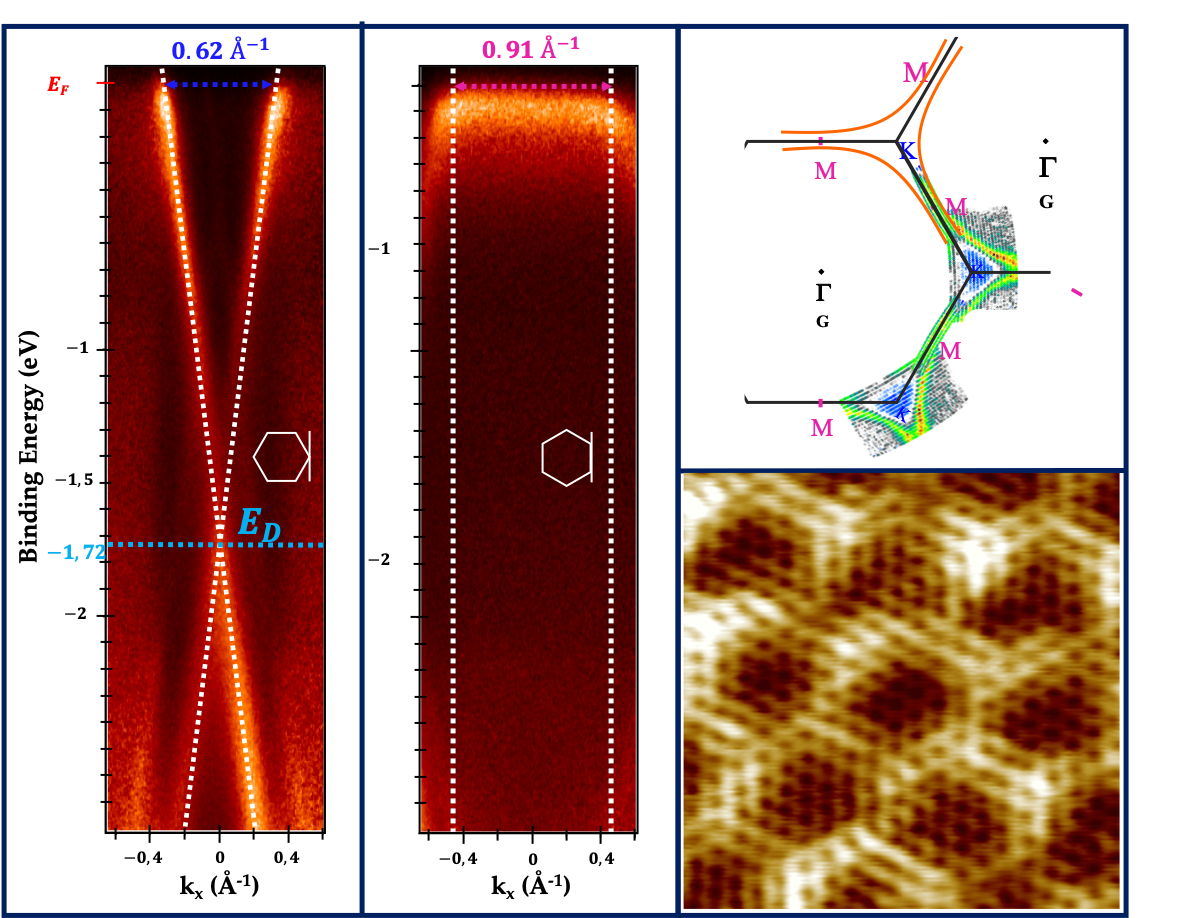Growth and Functionalization of 2D Materials – Band Structure Engineering
Growth and Functionalization of 2D Materials – Band Structure Engineering
D. Aubel, J.-L. Bubendorff, M. Cranney, E. Denys, A. Florentin, F. Vonau, and L. Simon
Contact : laurent.simon@uha.fr
The Low-Dimensional Systems Physics group explores various ways to modify the electronic properties of graphene layers and other 2D materials, or to use 2D materials in heterostructures. We use molecular beam epitaxy (MBE) under UHV, molecular evaporation by sublimation, or liquid-phase molecule deposition, either by ultra-fast valve injection or via electrospray techniques.
These UHV deposition chambers are connected to a low-temperature STM microscope capable of operating down to 4K, as well as to an XPS-ARPES analysis chamber equipped with a Scienta R3000 electron analyzer, a UV source, and monochromatized X-ray sources. This setup allows for a systematic investigation of the physico-chemical nature and the electronic band structure of the samples. We also regularly perform analyses using synchrotron radiation, particularly on the DEIMOS beamline at the SOLEIL facility.
For instance, we study 0D/2D van der Waals Al/AlOx core/shell structures on graphene and MoS₂ using photoemission and AFM, with the aim of developing magneto-Coulomb devices (ANR MIXES project, in collaboration with IPCMS – Strasbourg, UMPhy CNRS/Thales and SPEC – Paris-Saclay) [1].
In a multidisciplinary approach, we have investigated covalent grafting of molecules onto graphene, as well as interactions with self-assembled organic layers capable of modifying the Fermi level through charge transfer [2]. Recently, in collaboration with the Ångström Laboratory in Uppsala, we are also studying the creation of functionalized defects through fluorination, including a novel electron-beam fluorination process under SEM. This work has applications in gas sensors (NH₃, NO₂), which we are currently exploring in collaboration with ONERA[3-5].
Using metal intercalation, we work with epitaxial graphene on SiC (0001) substrates. Through high-temperature annealing under UHV (>1200°C), we can synthesize one or more epitaxial graphene layers. The method involves depositing atoms on this substrate and heating to different temperatures, leading to intercalation and substantial modifications of the graphene’s band structure [6-8]. While many elements can intercalate, we are particularly interested in the intercalation of lanthanides, which allows for extremely high levels of electron doping and enables exploration of graphene at critical points of its Brillouin zone, particularly when the Fermi level reaches specific energy states (van Hove singularities where Lifshitz transitions occur). This leads to the formation of flat bands, where strong electron-electron correlation effects are expected, potentially giving rise to new physical phenomena.

Flat band and Lifschitz transition in long-range ordered supergraphene obtained by Erbium intercalation © A. Zaarour
The figure illustrates this last topic. By intercalating Erbium atoms, we observed for the first time using STM a “supergraphene” with a new ordered structure, correlated with a Fermi surface and unprecedented band structure dispersions, including a very broad flat band at the M point, where the Lifshitz transition is reached [9]. We are investigating the effects of induced spin-orbit coupling and magnetic ordering mediated by the π-states of graphene on the topology of the Fermi surface, and are also studying the transport properties.
Publications
[1] Graphene/aluminum oxide interfaces for nanoelectronic devices VB Vu, JL Bubendorff, LDN Mouafo, S Latil, A Zaarour, JF Dayen, L Simon, Electronic Structure 5 (4), 045005 (2024)
[2] L. Daukiya, C. Mattioli, D. Aubel, S. Hajjar-Garreau, F. Vonau, E. Denys, G. Reiter, J. Fransson, E. Perrin, M.-L. Bocquet, C. Bena, A. Gourdon and L. Simon ACS Nano 11(1), 627-634 (2017) DOI : 10.1021/acsnano.6b06913
[3] E-beam Fluorinated CVD Graphene : in-situ XPS study on stability and NH3 adsorption doping effect V Malesys, T Duan, E Denys, H Li, K Leifer, L Simon, Nanotechnology 36 (9), 095701 (2024).
[4] Building a cm2 scale CVD graphene-based gas sensor : modelling the kinetic with a three-site adsorption/desorption Langmuir model V Malesys, A Andrieux-Ledier, P Lavenus, L Simon Nanotechnology 35 (28), 285501 (2024)
[5] Enhanced ammonia gas adsorption through site-selective fluorination of graphene, T. Duan, H. Li, L. Daukiya, L. Simon and K. Leifer Crystals 12(8), 1117 (2022) DOI : 10.3390/cryst12081117
[6] Functionalization of 2D materials by intercalation, L. Daukiya, M. N. Nair, M. Cranney, F. Vonau, S. Hajjar, D. Aubel and L. Simon, Progress in Surface Science 94(1), 1-20 (2019) DOI : 10.1016/j.progsurf.2018.07.001
[7] Highly -doped graphene generated through intercalated terbium atoms akshya Daukiya, MN Nair, Samar Hajjar-Garreau, Francois Vonau, Dominique Aubel, Jean-Luc Bubendorff, Marion Cranney, Emmanuel Denys, Alban Florentin, Günter Reiter, Laurent Simon, Physical Review B 97 (3), 035309 (2018) DOI : 10.1103/PhysRevB.97.035309
[8] M. N. Nair, M. Cranney, T. Jiang, S. Hajjar-Garreau, D. Aubel, F. Vonau, A. Florentin, E. Denys, M.-L. Bocquet and L. Simon
Physical Review B 94(7), 075427 (2016) DOI : 10.1103/PhysRevB.94.075427
[9] A. Zaarour, V. Malesys, J. Teyssandier, M. Cranney, E. Denys, J.-L. Bubendorff, A.Florentin, L. Josien, F. Vonau, D. Aubel, A. Ouerghi, C. Bena and L. Simon Phys. Rev. Research 5, 013099 (2023) DOI : 10.48550/arXiv.2207.12410

